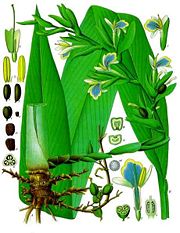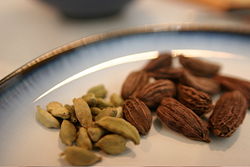Cardamom
| Cardamom | ||||||||||||
|---|---|---|---|---|---|---|---|---|---|---|---|---|
 True Cardamom (Elettaria cardamomum)
|
||||||||||||
| Scientific classification | ||||||||||||
|
||||||||||||
| Genera | ||||||||||||
|
The name cardamom (or cardamon) is used for herbs within two genera of the ginger family Zingiberaceae, namely Elettaria and Amomum. Both varieties take the form of a small seedpod, triangular in cross-section and spindle-shaped, with a thin papery outer shell and small black seeds. Elettaria pods are light green in color, while Amomum pods are larger and dark brown.
Contents |
Types and distribution
The two main genera of the ginger family that are named as forms of cardamom are distributed as follows:
- Elettaria (commonly called cardamom, green cardamom, or true cardamom) is distributed from India to Malaysia.
- Amomum (commonly known as black cardamom, brown cardamom, Kravan, Java cardamom, Bengal cardamom, Siamese cardamom, white or red cardamom) is distributed mainly in Asia and Australia.
The Sanskrit name for cardamom is "elā" or "truṭī." In Urdu/Hindi/Gujarati and some Southern Indian languages It is called "elaichi" or "elchi."
Varieties
Njallani
Njallani, also known as "rup-ree-t" is a unique high-yielding cardamom variety developed by an Indian farmer Sebastian Joseph at Kattappana in the South Indian state of Kerala.
Sebastian Joseph and his son Regimon let bees cross-pollinate the cardamom plants and came up with a new high-yielding variety that he named Njallani, after his ancestral home. This variety yields 1500 kg/hectare as compared to the conventional 200 kg/ha. The increased yield revolutionised cardamom cultivation in the state of Kerala. [1] [2] [3] [4]
Uses

Both forms of cardamom are used as flavorings in both food and drink, as cooking spices and as a medicine. Elettaria cardamomum (the usual type of cardamom) is used as a spice, a masticatory, and in medicine; it is also smoked sometimes; it is used as a food plant by the larva of the moth Endoclita hosei. Cardamom has a strong, unique taste, with an intensely aromatic fragrance. Black cardamom has a distinctly more astringent aroma, though not bitter, with a coolness similar to mint, though with a different aroma. It is a common ingredient in Indian cooking, and is often used in baking in Nordic countries, such as in the Finnish sweet-bread pulla. It is one of the most expensive spices by weight, and little is needed to impart the flavor. Cardamom is best stored in pod form, because once the seeds are exposed or ground, they quickly lose their flavor. However, high-quality ground cardamom is often more readily (and cheaply) available, and is an acceptable substitute. For recipes requiring whole cardamom pods, a generally accepted equivalent is 10 pods equals 1½ teaspoons of ground cardamom. In the Middle East, green cardamom powder is used as a spice for sweet dishes as well as traditional flavouring in coffee and tea. It is also used in some extent in savoury dishes. In Arabic, cardamom is called al-Hayl. In Persian, it is called hel. In some Middle Eastern countries, coffee and cardamom are often ground in a wooden mortar and cooked together in a mihbaz, an oven using wood or gas, to produce a mixtures that are as much as forty percent cardamom.
In South Asia, green cardamom is often used in traditional Indian sweets and in Masala chai (spiced tea).
Black cardamom is sometimes used in garam masala for curries. It is occasionally used as a garnish in basmati rice and other dishes. It is often referred to as fat cardamom due its size ('Moti Elaichi') Individual seeds are sometimes chewed, in much the same way as chewing-gum. In Northern Europe, cardamom is commonly used in sweet foods, pastries or cakes. It has also been known to be used for gin making.
In traditional medicine
Green cardamom in South Asia is broadly used to treat infections in teeth and gums, to prevent and treat throat troubles, congestion of the lungs and pulmonary tuberculosis, inflammation of eyelids and also digestive disorders. It is also reportedly used as an antidote for both snake and scorpion venom bite. Amomum is used as a spice and as an ingredient in traditional medicine in systems of the traditional Chinese medicine in China, in Ayurveda in India, Korea, Japan, and Vietnam.
Species in the genus Amomum are also used in traditional Indian medicine. Among other species, varieties and cultivars, Amomum villosum cultivated in China, Laos and Vietnam is used in traditional Chinese medicine to treat stomach-aches, constipation, dysentery, and other digestion problems. "Tsaoko" cardamom Amomum tsao-ko is cultivated in Yunnan, China and northwest Vietnam, both for medicinal purposes and as a spice. Increased demand since the 1980s, principally from China, for both Amomum villosum and Amomum tsao-ko has provided a key source of income for poor farmers living at higher altitudes in localized areas of China, Laos and Vietnam, people typically isolated from many other markets. Recently, Nepal has been the world's largest producer of large cardamom. These days, Guatemala has become the world's largest producer and exporter of cardamom, with a staggering export total of US$137.2 million for 2007.
Etymology
In Hindi, Urdu, and Gujarati cardamom is called elaichi, and "yelakki" in Kannada and other South Indian languages. It is called Elakka in Malayalam, which is the language of Kerala an Indian province that accounts for 70% of Indian cardamom.[5] In South Asia green cardamom, called "Elaichi" in Marathi, Hindi and Urdu. It is called "Elakkaay" in Telugu, "elam" (ஏலம்) in Tamil and "Gujurati" in Oriya.
Gallery
References
Notes
- ↑ Unsung Hero: Tale of an ingenious farmer. Rediff.com, 30 May 2007 [1]
- ↑ New cardamom variety. Njallani. National Innovation Foundation [2]
- ↑ Poor rainfall may hit cardamom crop. The Hindu Business Line, 06 July 2007 [3]
- ↑ Cardamom: Scientists, Njallani developers fight. CommodityOnline, 08 Jan 2008 [4]
Bibliography
- Mabberley, D.J. The Plant-book: A Portable Dictionary of the Higher Plants. Cambridge University Press, 1996.
- Gernot Katzer's Spice Pages: Cardamom
- Plant Cultures: botany and history of Cardamom
- Pham Hoang Ho 1993, Cay Co Vietnam [Plants of Vietnam: in Vietnamese], vols. I, II & III, Montreal.
- Buckingham, J.S. & Petheram, R.J. 2004, Cardamom cultivation and forest biodiversity in northwest Vietnam, Agricultural Research and Extension Network, Overseas Development Institute, London UK.
- Aubertine, C. 2004, Cardamom (Amomum spp.) in Lao PDR: the hazardous future of an agroforest system product, in 'Forest products, livelihoods and conservation: case studies of non-timber forest products systems vol. 1-Asia, Center for International Forest Research. Jakarta, Indonesia.
- Álvarez, L., Gudiel, V. 2008. 'Cardamom prices leads to a re-emergence of the green gold'. [6]
|
||||||||||||||||||||||||||||||||||||||||||